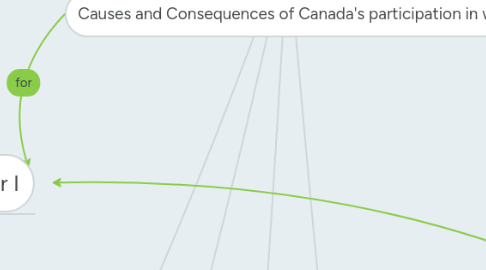
1. Causes
1.1. The communist North Korean armed forces invaded the democratic South Korea
1.2. The United Nations asked it's members to send some of their forces to resolve the conflict between the two countries. Canada got involved because they were a member of the United Nations
2. Causes
2.1. After WWII, the United States and the Soviet Nation competed to be the strongest nation in the world
2.2. Canada chose United States's side because they were a closer ally to them
3. Consequences
3.1. Canada's relation with the U.S. improved
4. Causes and Consequences of Canada's participation in war
5. World War I
6. Consequences
6.1. Casulties
6.1.1. Close to 56,000 Canadians were killed during the war
6.1.2. 172,000 Canadian soldiers were wounded
6.2. Economy
6.2.1. The financial cost of the war was $1,665,576,000 (which is worth more now)
6.2.2. Because of the war, Canada had to pay $164 million per year to pay off their debt. This cause the introduction of the modern day income tax.
6.2.3. They could participate in the war by being a nurse
6.3. Women
6.3.1. Women related to soldiers could now vote
6.3.2. Because of the shortage of men during the war, some women got jobs
6.3.3. Their contributions during the war also earned them more respect
7. Causes
7.1. Direct Cause
7.1.1. The direct cause of WWI was the assassination of Archduke Franz Ferdinand by Gavrilo Princip at Sarajevo on 28 June 1914.
7.2. Background Cause
7.2.1. M: Militarism
7.2.1.1. The belief in building up a strong armed forces to prepare your country for war.
7.2.2. A: Alliances
7.2.2.1. Countries agreed to support one another in case of an attack. 2 alliances would emerge.
7.2.2.1.1. Triple Entente (Allied Powers)
7.2.2.1.2. Triple Alliance (Central Powers)
7.2.3. I: Imperialism
7.2.3.1. Britain, France, Germany, Italy and Russia all scrambles for colonies in Africa, Asia and the Pacific. Each nation wanted new trade markets and the raw materials of these new regions.
7.2.4. N: Nationalism
7.2.4.1. Pride or devotion to one's country. Nationalism encouraged unity, and also would put nation against nation.
7.3. Canada's Cause
7.3.1. When Britain declared war, Canada was automatically involved
8. Cold War
9. Korean War
10. Consequences
10.1. Canadian casualties totalled 1,558 including 516 who died
11. South African War
12. Causes
12.1. Britain was against German and Dutch settlers to control the diamond mines. They asked Canada for help and some volunteers were sent
13. Consequences
13.1. 267 were killed
13.2. This sets up a precedent of helping Britian
14. Consequences
14.1. Casulties
14.1.1. More than 44,000 Canadians lost their lives
14.1.2. An estimated 54,000 Canadian soldiers were wounded.
14.2. Economy
14.2.1. The financial cost of the war was $21,786,077,519.13
14.2.2. Canada supplied many resources and raw materials to the war and thus their economy boomed, despite their debt of over $10 million dollars. The supplies Canada gave to the war had to be made in large supplies fast, resulting in many factories across Canada. The War also got them out of the Depression
14.3. Women
14.3.1. Could participate in the war by being a nurse, joining the Canadian Women’s Army Corps, joining the Canadian Women’s Auxiliary Air Force, and joining the Women’s Royal Canadian Naval Service
14.3.2. Some were promoted to higher positions so now they had more respect and authority from men
14.3.3. More jobs and not expected to give up those jobs when the war was over
14.3.4. Free child care was provided to women with certain jobs
15. World War II
16. Causes
16.1. Treaty of Versailles
16.1.1. stated
16.1.1.1. Germany is to blame for WWI
16.1.1.2. Germany has to pay $33 billion ($450 billion today)
16.1.1.3. France and England get most of Germany's colonies
16.1.1.4. The League of Nations is created with economic sanctions as their main tool
16.1.1.5. Alsace-Lorraine goes to France, Rhineland stays German but demilitirazied
16.1.1.6. Germany's army is limited to 100,000 men, no tanks, no planes, no submarines
16.1.2. The treaty was very harsh against Germany. Germany was forced to "accept the responsibility" of the war damages suffered by the Allies. The treaty required that Germany pay a huge sum of money called reparations. The problem with the treaty is that it left the German economy in ruins. People were starving and the government was in chaos.
16.2. Fascism
16.2.1. some countries were taken over by dictators who formed powerful fascist governments. These dictators wanted to expand their empires and began to look for new lands to conquer.
16.3. Japanese militarism and invasions of China
16.3.1. Japan was lacking resources and seeing the vast natural resources to be found in China and seeing her obvious weakness, invaded and occupied Manchuria.
16.4. Hitler and his Nazi Party
16.5. Appeasement
16.5.1. When countries such as Italy and Germany became aggressive and began to take over their neighbors and build up their armies, countries such as Britain and France hoped to keep peace through "appeasement." This meant that they tried to make Germany and Hitler happy rather than try to stop him. They hoped that by meeting his demands he would be satisfied and there wouldn't be any war.
16.6. The Great Depression
16.6.1. The period before World War II was a time of great economic suffering throughout the world called the Great Depression. Many people were out of work and struggling to survive. This created unstable governments and worldwide turmoil that helped lead to World War II.
16.7. Britain and France declaring war on Germany after it invaded Poland (Germany had already taken over Austria and Czechoslovakia) in September 1939.
16.7.1. Alliances
16.7.1.1. The Allies
16.7.1.1.1. United States
16.7.1.1.2. Britain
16.7.1.1.3. France
16.7.1.1.4. USSR
16.7.1.1.5. Australia
16.7.1.1.6. Belgium
16.7.1.1.7. Brazil
16.7.1.1.8. Canada
16.7.1.1.9. China
16.7.1.1.10. Denmark
16.7.1.1.11. Greece
16.7.1.1.12. Netherlands
16.7.1.1.13. New Zealand
16.7.1.1.14. Norway
16.7.1.1.15. Poland
16.7.1.1.16. South Africa
16.7.1.1.17. Yugoslavia
16.7.1.2. Axis powers
16.7.1.2.1. Germany
16.7.1.2.2. Italy
16.7.1.2.3. Japan
16.7.1.2.4. Hungary
16.7.1.2.5. Romania
16.7.1.2.6. Bulgaria
